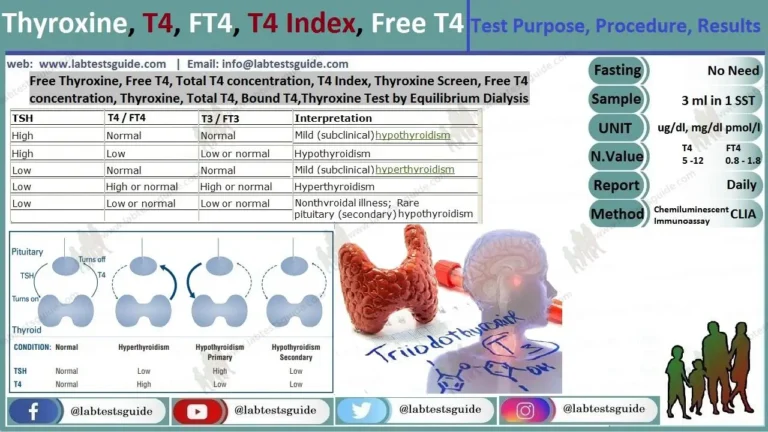4801 to 4850 MCQs for Lab Technician and Technologist Exam Preparation
5000 Plus MCQs for Lab Technician and Technologists are designed to test the knowledge and proficiency of laboratory professionals who work in the field of clinical laboratory science. These questions cover a wide range of topics related to laboratory science, including anatomy, physiology, microbiology, chemistry, and hematology.

If You like then share this to your friends and other social media.
If You have any question and suggestions then please Contact us Here
Questions 4801 to 4850
- Pyruvate kinase requires __ ions for maximum activity.
- Na+
- K+✔
- Ca2+
- Mg2+
- ATP is ‘wasted’ in Rapoport-Lueberring cycle in RBCs as otherwise it will inhibit
- Phosphoglucomutase
- Phosphohexo isomerase
- Phosphofructo kinase✔
- Phosphoenol pyruvate carboxy kinase
- The following co-enzyme is needed for the oxidative decarboxylation of ketoacids:
- NADP+
- TPP✔
- Folate coenzyme
- Biotin coenzyme
- Synthesis of Glucose from amino acids is termed as
- Glycolysis
- Gluconeogenesis✔
- Glycogenesis
- Lipogenesis
- The following examples are important heteropolysaccharides except
- Amylopectin✔
- Heparin
- Peptidoglycan
- Hyaluronic acid
- Whcih of the following features are common to monosaccharides?
- Contain asymmetric centres
- Are of 2 types – aldoses and ketoses
- Tend to exist as ring structures in solution✔
- Include glucose, galactose and raffinose
- Polysaccharides
- Contain many monosaccharide units which may or may not be of the same kind
- Function mainly a storage or structural compounds
- Are present in large amounts in connective tissue
- All of these✔
- The absorption of glucose in the digestive tract
- Occurs in the small intestine✔
- Is stimulated by the hormone Glucagon
- Occurs more rapidly than the absorption of any other sugar
- Is impaired in cases of diabetes mellitus
- UDP-Glucose is converted to UDPGlucuronic acid by
- ATP
- GTP
- NADP+
- NAD+✔
- The enzymes involved in Phosphorylation of glucose to glucose 6- phosphate are
- Hexokinase
- Glucokinase
- Phosphofructokinase
- Both (Hexokinase) and (Glucokinase)✔
- In conversion of Lactic acid to Glucose, three reactions of Glycolytic pathway are circumvented, which of the following enzymes do not participate?
- Pyruvate Carboxylase
- Phosphoenol pyruvate carboxy kinase
- Pyruvate kinase✔
- Glucose-6-phosphatase
- The normal resting state of humans, most of the blood glucose burnt as “fuel” is consumed by
- Liver
- Brain✔
- Kidneys
- Adipose tissue
- Which of the following compound is a positive allosteric modifier of the enzyme pyruvate carboxylase?
- Biotin
- Acetyl CoA✔
- Oxaloacetate
- ATP
- A specific inhibitor for succinate dehydrogenase is
- Arsinite
- Melouate✔
- Citrate
- Cyanide
- Most of the metabolic pathways are either anabolic or catabolic. Which of the following pathways is considered as “amphibolic” in nature?
- Glycogenesis
- Glycolytic pathway
- Lipolysis
- TCA cycle✔
- Transketolase activity is affected in
- Biotin deficiency
- Pyridoxine deficiency
- PABA deficiency
- Thiamine deficiency✔
- The following metabolic abnormalities occur in Diabetes mellitus except
- Increased plasma FFA
- Increased pyruvate carboxylase activate
- Decreased lipogenesis
- Decreased gluconeogenesis✔
- A substance that is not an intermediate in the formation of D-glucuronic acid from glucose is
- Glucoss-1-p
- 6-Phosphogluconate✔
- Glucose-6-p
- UDP-Glucose
- The hydrolysis of Glucose-6-P is catalysed by a phosphatase that is not formed in which of the following?
- Liver
- Kidney
- Muscle✔
- Small intestine
- An essential for converting Glucose to Glycogen in Liver is
- Lactic acid
- GTP
- CTP
- UTP✔
- Which of the following is a substrate for aldolase activity in Glycolytic pathway?
- Glyceraldehyde-3-p
- Glucose-6-p
- Fructose-6-p
- Fructose1, 6-bisphosphate✔
- The ratio that approximates the number of net molecule of ATP formed per mole of Glucose oxidized in presence of O2 to the net number formed in abscence of O2 is
- 4 : 1
- 10 : 2
- 12 : 1
- 18 : 1✔
- The “Primaquin sensitivity types of haemolytic anaemia has been found to relate to reduced R.B.C activity of which enzyme?
- Pyruvate kinase deficiency
- Glucose-6-phosphatase deficiency
- Glucose-6-p dehydrogenase deficiency✔
- Hexokinase deficiency
- Which of the following hormones is not involved in carbohydrate metabolism?
- Cortisol
- ACTH
- Glucogen
- Vasopressin✔
- Dehydrogenases involved in HMP shunt are specific for
- NADP+✔
- NAD+
- FAD
- FMN
- Which of the following enzymes in Glycolytic pathway is inhibited by fluoride?
- Glyceraldehyde-3-p dehydrogenase
- Phosphoglycerate kinase
- Pyruvate kinase
- Enolase✔
- Out of 24 mols of ATP formed in TCA cycle, 2 molecules of ATP can be formed at “substrate level” by which of the following reaction ?
- Citric acid→ Isocitric acid
- Isocitrate→ Oxaloacetate
- Succinic acid→ Fumarate
- Succinylcat→ Succinic acid✔
- Which of the following statements regarding T.C.A cycle is true?
- It is an anaerobic process
- It occurs in cytosol
- It contains no intermediates for Gluconeogenesis
- It is amphibolic in nature✔
- An allosteric enzyme responsible for controlling the rate of T.C.A cycle is
- Malate dehydrogenase
- Isocitrate dehydrogenase✔
- Fumarase
- Aconitase
- The glycolysis is regulated by
- Hexokinase
- Phosphofructokinase
- Pyruvate kinase
- All of these✔
- How many ATP molecules will be required for conversion of 2-molecules of Lactic acid to Glucose?
- 2
- 4
- 8
- 6✔
- Which of the following enzyme is not involved in HMP shunt?
- Glyceraldehyde-3-p dehydrogenase✔
- Glucose-6-p-dehydrogenase
- Transketolase
- Phosphogluconate dehydrogenase
- In presence of the following cofactor, pyruvate carboxylase converts pyruvate to oxaloacetate:
- ATP, Protein and CO2
- CO2 and ATP✔
- CO2
- Protein
- For conversion of oxaloacetate to phosphoenol pyruvate, high energy molecule is required in the form of
- GTP only
- ITP only
- GTP (or) ITP✔
- None of these
- If the more negative standard reduction potential of a redox pair, the greater the tendency to
- To lose electrons✔
- To gain electrons
- To lose/gain electrons
- To lose and gain electrons
- Electron transport and phosphorylation can be uncoupled by compounds that increase the permeability of the inner mitochondrial membrane to
- Electrons
- Protons✔
- Uncouplers
- All of these
- The more positive the E0, the greater the tendency of the oxidant member of that pair to
- Lose electrons
- Gain electrons✔
- Lose (or) gain electrons
- Lose and gain electrons
- The standard free energy of hydrolysis of terminal phosphate group of ATP is
- –7,300 cal/mol✔
- –8,300 cal/mol
- 10,000 cal/mol
- +7,300 cal/mol
- The transport of a pair of electrons from NADH to O2 via the electron transport chain produces
- –52,580 cal✔
- –50,580 cal
- 21,900 cal
- +52,580 cal
- Sufficient energy required to produce 3 ATP from 3 ADP and 3 pi is
- –21,900 cal✔
- 29,900 cal
- 31,900 cal
- 39,900 cal
- The free energy change, AG
- Is directly proportional to the standard free energy change, AG
- Is equal to zero at equilibrium✔
- Can only be calculated when the reactants and products are present at 1mol/1 concentrations
- Is equal to –RT in keq
- Under standard conditions
- The free energy change ∆G°, is equal to 0
- The standard free energy change ∆G, is equal to 0
- The free energy change, ∆G°, is equal to the standard free energy change, ∆G°✔
- Keq is equal to 1
- An uncoupler of oxidative phosphorylation such as dinitrophenol
- Inhibits electron transport and ATP synthesis
- Allow electron transport to proceed without ATP synthesis✔
- Inhibits electron transport without impairment of ATP synthesis
- Specially inhibits cytochrome b
- All of the following statements about the enzymic complex that carries out the synthesis of ATP during oxidative phosphorylation are correct except
- It is located on the matrix side of the inner mitochondrial membrane
- It is inhibited by oligomycin
- It can exhibit ATPase activity
- It can bind molecular O2✔
- Glucokinase
- Is widely distributed and occurs in most mammalian tissues
- Has a high km for glucose and hence is important in the phosphorylation of glucose primarily after ingestion of a carbohydrate rich meal✔
- Is widely distributed in Prokaryotes
- None of these
- The reaction catalysed by phosphofructokinase
- Is activated by high concentrations of ATP and citrate
- Uses fruitose-1-phosphate as substrate
- Is the rate-limiting reaction of the glycolytic pathway✔
- Is inhibited by fructose 2, 6-bisphosphate
- Compared to the resting state, vigorously contracting muscle shows
- An increased conversion of pyruvate to lactate✔
- Decreased oxidation of pyruvate of CO2 and water
- A decreased NADH/NAD+ ratio
- Decreased concentration of AMP
- Which one of the following would be expected in pyruvate kinase deficiency?
- Increased levels of lactate in the R.B.C
- Hemolytic anemia✔
- Decreased ratio of ADP to ATP in R.B.C
- Increased phosphorylation of Glucose to Glucose-6-phosphate
- Which one of the following statements concerning glucose metabolism is correct?
- The conversion of Glucose to lactate occurs only in the R.B.C
- Glucose enters most cells by a mechanism in which Na+ and glucose are co-transported
- Pyruvate kinase catalyses an irreversible reaction✔
- An elevated level of insulin leads to a decreased level of fructose 2, 6-bisphosphate in hepatocyte
- Which one of the following compounds cannot give rise to the net synthesis of Glucose?
- Lactate
- Glycerol
- α-ketoglutarate
- Acetyl CoA✔
The questions are typically designed to assess the technical skills and knowledge required for the laboratory profession, including the ability to analyze laboratory test results, perform laboratory procedures, and maintain laboratory equipment.
To prepare for these MCQs, candidates should have a thorough understanding of the key concepts and principles of laboratory science. They should also be familiar with common laboratory equipment and procedures, as well as laboratory safety protocols.
Candidates may also benefit from studying specific laboratory science textbooks or taking online courses that cover the material tested in the MCQs. Additionally, practicing sample MCQs and reviewing the answers can help candidates identify areas where they may need to improve their knowledge or skills.
Overall, the MCQs for lab technologists are designed to be challenging and comprehensive, requiring candidates to demonstrate a high level of proficiency in the field of laboratory science.
Possible References Used







